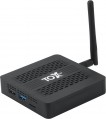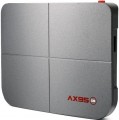Operating system
—
Proprietary system. The operating system of the device is represented by the proprietary software shell of the manufacturer. Usually, such operating systems have an attractive and convenient menu. A proprietary operating system is developed directly by the manufacturer for the hardware resources of a particular model or a whole line, but has limited capabilities.
—
Android (AOSP). This type of operating system is a modification of the popular Android OS, mainly notable for being open source. It is a versatile operating system that gives the user much more freedom to create changes and customizations within the system itself. At the same time, the installation and stability of certain applications on this platform are not guaranteed, and the overall system management was not specially “tailored” for large screens, which may cause some inconvenience. First of all, such solutions will interest users who understand the features of the Android OS, like to customize and control everything for themselves, and have time for this.
—
Android TV. Devices of this type have full-fledged Android TV software, specially adapted to work on large screens. In accordance with the name, it is a type of Android OS, specially designed for such equipment. In addition to the common features of all Androids (such as the ability to install additional applications, including
...even games), it has a number of special features: an optimized interface, integration with smartphones (including the ability to use them as a remote control), voice search, etc. Thanks to this, TVs with this feature are significantly superior in functionality to models with a “regular” Smart TV. Of course, a dedicated processor, graphics subsystem and memory are provided for the operation of a multifunctional OS, and the presence of such hardware resources is reflected in the overall cost.
— Google TV. Rebranding of the Android TV platform for TVs and smart consoles, or rather, a new shell on top of the operating system under the sign of the “green droid”, introduced since 2021. Among the innovations, it has a redesigned user interface, an improved knowledge base that more efficiently distributes content by genre and collects search information from the entire list of installed applications and subscriptions. The voice assistant now understands the needs of the audience better and provides a detailed list of what was found. A separate tab in the interface contains live broadcasts of current events, whether it be sports events or a rocket launch to Mars. Among other things, the aspects that involve the use of TV as a command post for managing a single ecosystem of a “smart” home have been improved in the system.Card reader
A device for reading memory cards, most often in SD format. This feature is especially useful for exchanging information with some types of modern electronics: almost all cameras and laptops are equipped with card readers, and microSD cards used in smartphones and other pocket gadgets can be used in SD slots using simple adapters. Thanks to the
card reader, you can, for example, easily view materials captured on a camera or smartphone camera, copy music and movies from a laptop to a media centre, and even perform some special tasks, such as updating the player's firmware. In video capture devices, the built-in card reader allows user to add the drive to the list of computer disks.
HDMI
HDMI is the most common modern interface for working with HD content and multi-channel audio. Video and audio signals with this connection are transmitted over a single cable, and the bandwidth in the latest versions (
HDMI 2.0 and
HDMI 2.1) is enough to work with UltraHD resolution and even higher. Almost any modern screen (TV, monitor, etc.) with HD support has at least one HDMI input, which is why most media players and TV receivers have outputs of this type. However, there are also models without HDMI — these are mostly outdated or the most inexpensive solutions that use only analogue video interfaces. There are also models for several HDMI and in most cases one of these ports is for the incoming signal, while the HDMI ports differ in versions.
— v 1.4. The version presented back in 2009, however, does not lose popularity to this day. Supports 4K (4096x2160) video at 24 fps and Full HD at 120 fps; the latter, among other things, allows you to transfer 3D video over this interface. In addition to the original v 1.4, there are also improved versions v 1.4a and v 1.4b, where the possibilities for working with 3D have been further expanded.
-v 2.0. Version released in 2013. Among other things, it introduced the ability to work with 4K video at speeds up to 60 fps, compatibility with ultra-wide format 21: 9, as well as support for up to 32 channels and 4
...audio streams simultaneously. HDR support was not originally included in this release, but was introduced in v 2.0a and further enhanced in v 2.0b; media players from this category can support both the original version 2.0 and one of the improved ones.
— v 2.1. 2017 version, also known as HDMI Ultra High Speed. Indeed, it provides a very solid bandwidth, allowing you to work even with 10K video at a speed of 120 fps; in addition, a number of improvements have been made to HDR support. Note that the full use of HDMI v 2.1 is possible only with a special cable, but the functions of earlier versions remain available when using conventional wires. LAN
LAN — connector for wired connection to the Internet and/or local area network using an Ethernet cable. A wired connection is not as convenient as Wi-Fi (see "Multimedia"), but it is considered more reliable and provides faster data transfer speeds. And the speed indicators depend on the device and can be 100 Mbps and 1 Gbps.
AV output
—
AV output. Analogue output for video and audio transferring. Previously, due to the large size of the equipment, it consisted of 3 RCA jacks and was connected to the TV accordingly. Now the devices have become more compact and don't have free space on the case. Therefore, the AV output is a single headphone jack, to which a tee cable is already connected (check availability in the package). Since all components of the video signal are on the same cable, the picture quality and immunity to interference are low.
Optical output
A variation of the SP/DIF audio interface that uses a TOSLINK fibre optic cable. Like the coaxial connector,
the optical output uses a digital data transfer format and can work with multi-channel audio. At the same time, optical fibre requires rather delicate handling, but it is absolutely insensitive to electrical interference.
Audio output (3.5 mm)
The presence of an audio output in most cases implies
a 3.5 mm mini-Jack connector for headphones. This connector does not transmit high power, which can fully supply the TV with an audio signal, but for compact devices, which include headphones, it will come in handy, since most household wired headphones are produced with a 3.5 mm plug. Headphones can be useful in noisy environments, or vice versa, when loud sound is undesirable, as well as in situations where sound must be listened to attentively (for example, when listening to radio broadcasts to learn a foreign language).
CPU
The model of the CPU installed in the media player.
This information is mainly of reference value: the processor is selected in such a way as to provide certain practical characteristics (maximum resolution, support for certain standards, embedded applications, etc.). So when choosing, you should focus primarily on these specifications. However, if you wish, knowing the processor model, you can find detailed data on it and evaluate the capabilities of the media centre to work with resource-consuming applications. This can be useful, in particular, if you choose an Android model (see above) and plan to use additional software intensively — the set of applications for this OS is very extensive, and some of them are quite demanding on system resources.
Also note that CPU data is often specified for advertising purposes — to emphasize that the device has a fairly advanced chip from a well-known brand. Among the most common brands of such processors are
Allwinner,
Amlogic,
Rockchip,
Realtek.
Built-in memory
The volume of
its own storage installed in the media player.
In this case, storage means permanent memory available to the user — the storage that you can fill with movies, music, applications, etc. The larger the volume of such storage, the more convenient it is for the user; on the other hand, this parameter significantly affects the cost of the entire device. In addition, it should noted that external media are also quite suitable for films and other multimedia content — flash drives, portable HDDs, drives installed in a slot (see below), optical discs, etc. So specifically look for a model with a capacious storage makes sense in two main cases. The first is if you want to keep an extensive collection of content in the media player, so as not to bother once again with connecting flash drives, loading disks, etc. it is best to put it in the built-in memory, and often this is the only possible option).
As for specific volumes, the capacity
up to 4 GB is considered very limited nowadays; such a storage is not enough even for a movie in HD 720p, its purpose is mainly to store a small set of applications.
8 GB and
16 GB are also relatively small, but this already allows you to work with a fairly extensive set of software and store individual movies in HD resolutions. And if you initially intend to store a large amount of c
...ontent on the device, you should definitely pay attention to models with a capacity of 32 GB or more.
